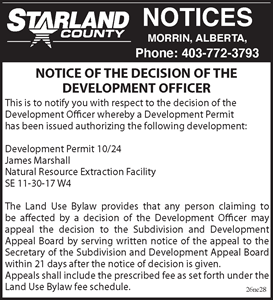In lead up to the plebiscite questioning whether John Anderson Park is a suitable location for constructing a community facility, The Mail sat down with Tony Lacher, chairman of the Badlands Sportsplex and Community Facility Committee to learn more about the campaign to vote yes, and its implications.
-Can you explain how this committee came together?
A group of concerned community citizens came together in early 2008 to discuss why the plebiscite failed. We looked at what was done well, what could have been done better and what could have been done differently.
–After the first plebiscite, why did you feel it was important to keep the vision of a recreation facility alive?
Through numerous meetings, it was determined the plan had merit, the community at large supported some type of facility and most agreed some sort of development should occur sooner rather than later.
-Since then how has it grown? What kind of support have you been able to wrangle?
After gathering feedback from a cross section of residents, user groups, business owners and potential facility users, it was determined that there was strong support from the community and a decision was made to press forward. The informal committee presented their findings to Town Council which initiated a formal questionnaire that would accompany the local census. We talked to our local MLA, Jack Hayden, who also supported our direction. The committee invited a presentation from Doc Seaman and subsequently secured an arena project valued at $1 million.
-I have had quite a few people tell me, in their mind, they have already closed the book on the idea, that the last plebiscite settled the issue once and for all. How is this question different?
The last plebiscite question dealt with a specific building to be constructed on John Anderson Park. The building and the location were both incorporated into a single question so it was impossible to determine if the resulting “No” vote was a no to the building project or to the land location. After talking to a variety of voters, it was determined that some voted against the project while others voted against the location. The question today deals solely with the location so the resulting vote will clearly indicate whether or not anything should be built on the John Anderson location.
-If it is not about the facility itself, what is the facility going to look like?
No preliminary work has been done on the facility itself. The eventual site location, costing, and the communities priorities will drive this part of the process.
-Who are some of the stake holders in the community that you have consulted, or are going to consult?
The group has already heard presentations from interested associations and parties which would benefit from some sort of development. Some of these include the artists association, the pottery guild, health and wellness.
-Tell me about John Anderson and John Anderson Park?
John Anderson was a local athlete, who later in life contracted diabetes and had his leg amputated. Current Drumheller Mail editor, Ossie Sheddy, told our meeting he remembers John very well, administering himself insulin shots and writing editorials for The Mail. In Ossie’s opinion, John would be overjoyed in seeing a multi use facility where the ball park stands that carried his name for all these years.
The ball park was named after John Anderson by the sitting City Council in 1962, in dedication to the omnipresent sports figure in the valley. John Anderson never owned the lands, nor was it donated by him.
-Why is it a good site?
There are a number of reasons as to why the committee has selected John Anderson as the ideal site after reviewing other options around the community. These are:
1) The land is already owned by the Town, hence there are significant project savings versus purchasing private lands.
2) John Anderson is centrally located in the heart of the town, is in close proximity to existing infrastructure and is located in the downtown core. This is important when considering the operation requirements and efficiency gained once the project is built and operational.
3) The site is already serviced.
4) Significant dollars have already been spent on soil analysis and testing. The results indicate the site can handle the proposed development. This is a project savings as these costs would have to be again incurred at an alternate site.
5) The size of John Anderson is large enough to handle a project of this size.
- Are there any concerns about flooding?
The Town of Drumheller’s flood and dyking plan is independent of the project. Any project to be built would be built to the 1 in 100 year flood level or better.
-Are there other site options?
There are limited number of locations within the Town of Drumheller because of its geography. None would compare to the John Anderson location and all would add substantial costs to any development project.
-If the plebiscite is successful, what is the next step?
Once the site is secured, the committee will proceed in developing a conceptual plan which would be in line with the community's needs and priorities, as expressed in the recent census survey. It is important to note since the census survey, there have been three independent surveys conducted by other parties and these findings also support the original census survey results. We think this sends a pretty strong message as to what the people really want. A successful plebiscite will move this project forward and provide the community with facilities they can be proud of, while improving our quality of life. Let’s all make Drumheller a great place to work and play.
A group of concerned community citizens came together in early 2008 to discuss why the plebiscite failed. We looked at what was done well, what could have been done better and what could have been done differently.
–After the first plebiscite, why did you feel it was important to keep the vision of a recreation facility alive?
Through numerous meetings, it was determined the plan had merit, the community at large supported some type of facility and most agreed some sort of development should occur sooner rather than later.
-Since then how has it grown? What kind of support have you been able to wrangle?
After gathering feedback from a cross section of residents, user groups, business owners and potential facility users, it was determined that there was strong support from the community and a decision was made to press forward. The informal committee presented their findings to Town Council which initiated a formal questionnaire that would accompany the local census. We talked to our local MLA, Jack Hayden, who also supported our direction. The committee invited a presentation from Doc Seaman and subsequently secured an arena project valued at $1 million.
-I have had quite a few people tell me, in their mind, they have already closed the book on the idea, that the last plebiscite settled the issue once and for all. How is this question different?
The last plebiscite question dealt with a specific building to be constructed on John Anderson Park. The building and the location were both incorporated into a single question so it was impossible to determine if the resulting “No” vote was a no to the building project or to the land location. After talking to a variety of voters, it was determined that some voted against the project while others voted against the location. The question today deals solely with the location so the resulting vote will clearly indicate whether or not anything should be built on the John Anderson location.
-If it is not about the facility itself, what is the facility going to look like?
No preliminary work has been done on the facility itself. The eventual site location, costing, and the communities priorities will drive this part of the process.
-Who are some of the stake holders in the community that you have consulted, or are going to consult?
The group has already heard presentations from interested associations and parties which would benefit from some sort of development. Some of these include the artists association, the pottery guild, health and wellness.
-Tell me about John Anderson and John Anderson Park?
John Anderson was a local athlete, who later in life contracted diabetes and had his leg amputated. Current Drumheller Mail editor, Ossie Sheddy, told our meeting he remembers John very well, administering himself insulin shots and writing editorials for The Mail. In Ossie’s opinion, John would be overjoyed in seeing a multi use facility where the ball park stands that carried his name for all these years.
The ball park was named after John Anderson by the sitting City Council in 1962, in dedication to the omnipresent sports figure in the valley. John Anderson never owned the lands, nor was it donated by him.
-Why is it a good site?
There are a number of reasons as to why the committee has selected John Anderson as the ideal site after reviewing other options around the community. These are:
1) The land is already owned by the Town, hence there are significant project savings versus purchasing private lands.
2) John Anderson is centrally located in the heart of the town, is in close proximity to existing infrastructure and is located in the downtown core. This is important when considering the operation requirements and efficiency gained once the project is built and operational.
3) The site is already serviced.
4) Significant dollars have already been spent on soil analysis and testing. The results indicate the site can handle the proposed development. This is a project savings as these costs would have to be again incurred at an alternate site.
5) The size of John Anderson is large enough to handle a project of this size.
- Are there any concerns about flooding?
The Town of Drumheller’s flood and dyking plan is independent of the project. Any project to be built would be built to the 1 in 100 year flood level or better.
-Are there other site options?
There are limited number of locations within the Town of Drumheller because of its geography. None would compare to the John Anderson location and all would add substantial costs to any development project.
-If the plebiscite is successful, what is the next step?
Once the site is secured, the committee will proceed in developing a conceptual plan which would be in line with the community's needs and priorities, as expressed in the recent census survey. It is important to note since the census survey, there have been three independent surveys conducted by other parties and these findings also support the original census survey results. We think this sends a pretty strong message as to what the people really want. A successful plebiscite will move this project forward and provide the community with facilities they can be proud of, while improving our quality of life. Let’s all make Drumheller a great place to work and play.

















